Impact of Prototyping in Product Development
Rapid prototyping is an early release or a sample of a product in development. It is a technique used to quickly build a physical model of a three-dimensional computer-aided design otherwise known as CAD. It is normally constructed using 3D printing or “additive layer manufacturing” technology. Prototyping plays a large role in product development as it is the initial step before production and manufacturing. It is the process where designers can implement their design, make changes, and test it before it is finalized and moved into production. Prototyping has a lot of importance among engineering designers and manufacturers because it offers an immediate and accurate way to determine the potential of any given product. It’s important to note that rapid prototyping is different from 3D printing/additive manufacturing. Rapid prototyping is the process by which a prototype is fabricated from a CAD file.
With prototyping, designers and engineers can find better ways in overcoming potential project hurdles, higher costs, and most importantly, avoid large-scale production disasters. Here are some other key benefits of rapid prototyping in product development:
Understanding the Look and Feel of the Design
There is no better way to visualize your design than to have the physical product itself. Designers can see how their ideas are translated into a physical product, which provides them better insight into whether or not their design will work. This leads to the proof of concept. Knowing whether or not a product will actually work is not possible when visualized only through a CAD model. One must be able to look, feel, and utilize the product to approve of its design and capabilities.
Make Instant Changes While Saving Time and Costs
It is rare to develop a perfect product merely through a CAD model. It is usually during the prototyping phase that potential issues can be identified. At this point, changes and tweaks to the product can be made instantly at virtually no cost. The prototype is there exactly for that purpose: to be tested and constantly changed until it reaches a perfect state before being produced in mass quantities.
Identifying Design Flaws
A physical prototype will allow designers to test the physical properties of a product, particularly its strength. This will minimize design flaws and make immediate improvements as needed. It also allows us to experience how a customer would connect with the product before it reaches the hands of consumers. At this stage of prototyping, it is beneficial to partner with an electronic manufacturing service that can provide a fresh perspective. Often, it is possible that working so closely with something over long periods of time can hinder one’s ability to see or recognize design flaws. A new perspective can help to accelerate this step and gain new insight into developing a better product.
Creating Custom Designs and Upgrades
Prototyping is also used to take original designs and create new custom designs or upgrades to existing products. If a designer is looking to launch a new feature or design to an existing product, they could do so by tinkering with the original prototype. Again, this can save a lot on time and costs for developing a new product as a prototype is intended to be learned from, tested, and replicated.
There are four crucial steps in successful prototyping:
- Determine the need of the users: In order to develop a successful product, the needs of the users must be understood. Whether you conduct research of a specific group of consumers or are trying to provide a solution for an existing problem, understanding how the product will fit the needs of its intended users will help the design process go over smoothly.
- Designing and building the prototype: Design and implementation could be the most challenging parts. An experienced electronic manufacturing contractor can provide the tools and expertise necessary to design the perfect prototype.
- Putting the prototype through vigorous testing: The main aspect of this stage is to determine whether or not the product in its physical state meets the needs of the consumer. The strength, ability, and safety standards of the product will be tested.
- Finalizing the product: This stage ensures that all requirements are met before the prototype moves into mass production.
The use of rapid prototyping in product design and development has costs of its own; however, it is a highly profitable decision. In any manufacturing organization, it is greatly encouraged in order to avoid production disasters. In an oversaturated and competitive landscape, prototyping is a tool that can provide a competitive edge by saving on costs and rapidly increasing production times.
If you’re looking for innovative electronics manufacturing solutions for your business, contact Circuit Central in Markham by calling 1 (888) 602-7264 or, if you have any comments or questions, feel free to fill out a contact form.
Our engineering and design services span many industries, from commercial to industrial, medical, communication, and consumer, as well as aerospace and defence. We are your one-stop shop when it comes to product design. However, our services do not end with design. We also offer first-rate electronic prototyping and small-batch manufacturing.
Electronic prototyping allows you to test your design with less capital and risk. Our combination of modelling capabilities and reliable prototype suppliers allows us to create electronic prototypes that will help you to demonstrate your product prior to proceeding to the manufacturing stage.

